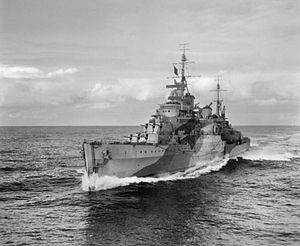HMS Liverpool (C11)

Liverpool underway on 28 February 1942
|
|
| History | |
|---|---|
|
|
|
| Name: | HMS Liverpool |
| Ordered: | 1935 |
| Builder: | Fairfield Shipbuilding and Engineering Company, Govan |
| Laid down: | 17 February 1936 |
| Launched: | 24 March 1937 |
| Commissioned: | 2 November 1938 |
| Decommissioned: | 1952 |
| Identification: | Pennant number: C11 |
| Honours and awards: |
Mediterranean 1940, Calabria 1940, Arctic 1942, Malta Convoys 1942 |
| Fate: | Sold for scrap July 1958 |
| General characteristics (original configuration) | |
| Class and type: | Town-class light cruiser |
| Displacement: |
|
| Length: | 591.6 ft (180.3 m) |
| Beam: | 62.4 ft (19.0 m) |
| Draught: | 20.7 ft (6.3 m) |
| Propulsion: |
|
| Speed: | 32.3 kn (59.8 km/h) |
| Complement: | 800–850 |
| Armament: |
|
| Armour: |
|
| Aircraft carried: | Three Supermarine Walrus; one catapult |
HMS Liverpool, named after the port city of Liverpool in north-west England, was a Town-class light cruiser of the Royal Navy in service from 1938 to 1952.
During the Second World War, Liverpool gained four battle honours and was seriously damaged in two attacks by Italian torpedo bombers. The cruiser operated variously with the naval stations in the East Indies and China and with the Mediterranean and Home fleets. While assigned to the China Station in January 1940, the cruiser instigated a diplomatic incident with Japan when she intercepted the liner Asama Maru off the coast of Japan. Liverpool fought in the battles of the Espero Convoy and Calabria, the Arctic Convoys, and Operation Harpoon during the Malta Convoys. An aerial attack on 14 June 1942, during Operation Harpoon, proved to be the ship's final combat of the war. For the remainder of the conflict, Liverpool underwent repairs and refitting at Rosyth, Scotland.
Liverpool returned to service in 1945 for assignment to the Mediterranean Fleet. In the early 1950s, the cruiser harboured in Port Said to support the British Administration of the Suez Canal Zone, when Egyptian guerrillas campaigned against it. The cruiser was decommissioned in 1952 at a time when the Royal Navy was rapidly contracting in strength. Liverpool was broken up in 1958, at Rosyth.
...
Wikipedia
